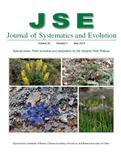Bo XU, Zhi-Min LI, Hang SUN
There have been few studies of the alpine subnival belt flora in the Hengduan Mountains (HM), which host remarkable biodiversity. To extend knowledge of this flora, we examined published florae, herbarium specimens, and field observations (and material) collected by both ourselves and others. In total, 942 seed plant species have been recorded in the belt, representing 168 genera and 48 families. Twenty-four large families (with ≥10 species) are present, represented by 873 species (92.68% of the total). These include Asteraceae, Saxifragaceae, and Brassicaceae (146, 82, and 71 species, respectively). There are also 27 large genera (represented by ≥10 species), collectively contributing 587 species (62.31%) to the flora, including Saxifraga, Corydalis, and Saussurea (75, 55, and 49 species, respectively). Areal elements represented by the highest numbers of genera are the North temperate, Sino-Himalaya, and Old World temperate elements (39.88%, 14.29%, and 12.50%, respectively), while the Hengduan Mountains, Sino-Himalaya, and Qinghai-Tibetan Plateau elements are most species-rich (355, 281, and 161 species, respectively), collectively accounting for 84.61% species of the known flora. Of these, 295 species (31.32%) are endemic to the Sino-Himalayan alpine subnival belt and 151 (16.03%) strictly endemic to the alpine subnival belt of the HM. These findings indicate that the flora is young, strongly differentiated, probably developed as a result of the plateau's uplift, and speciation has been accelerated by the harsh environment and strong heterogeneity of niches.

